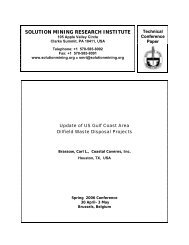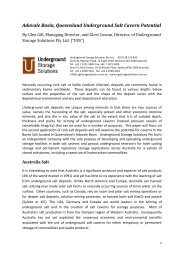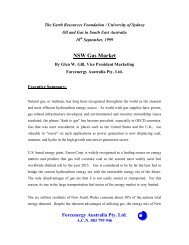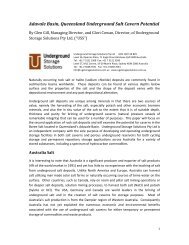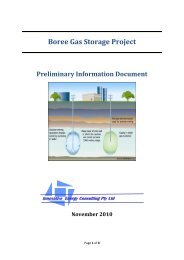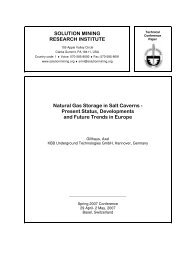Underground Gas Storage Glossary - Innovative Energy Consulting ...
Underground Gas Storage Glossary - Innovative Energy Consulting ...
Underground Gas Storage Glossary - Innovative Energy Consulting ...
Create successful ePaper yourself
Turn your PDF publications into a flip-book with our unique Google optimized e-Paper software.
<strong>Innovative</strong> <strong>Energy</strong> <strong>Consulting</strong> Pty Ltdcalled a Caprock and sealed laterally either by impermeable rocks (stratigraphictrap) or by structural closure (structural trap). Furthermore most structural trapsdo not have a bottom seal, a particular concern when Delta-Pressuring such areservoir for the Injected <strong>Gas</strong> under such conditions may push down thegas/water or gas/oil contact, as the case may be, and leak out of the trap at theSpill Point. Conversely, in a stratigraphic trap the container for the hydrocarbonis formed by lateral and vertical changes in rock type, within the same formation.In most stratigraphic traps the porous reservoir is completely surrounded by nonporousmaterial and therefore makes excellent underground gas storagecontainers (low Cushion <strong>Gas</strong> requirement, good Delta-Pressuring potential andexcellent Containment features).High Deliverability Multiple Cycle (HDMC) <strong>Storage</strong>: A depleted reservoirstorage facility whose design allows a relatively quick turnover of the working gascapacity and therefore multiple cycles per year or a Salt Cavern <strong>Storage</strong>.Hydrostatic Pressure Gradient: The hydrostatic pressure gradient is 0.433psi/ft.Injection Capacity (or rate) is the complement of the deliverability or withdrawalrate - it is the amount of gas that can be injected into a storage facility on a dailybasis. Injection capacity is usually expressed in MMcf/d, Bcf/d, TJ/d or PJ/d andtypically stated as the maximum or peak daily injection capacity available whenthe storage container is at the minimum operating pressure. The injectioncapacity of a storage facility is also variable, and is dependent on factorscomparable to those that determine deliverability. By contrast, the injection ratevaries inversely with the total amount of gas in storage: it is at its lowest when thereservoir is most full and increases as working gas is withdrawn. Whenbenchmarking storage facilities the injection capacity is usually stated as apercent (%) of the working gas capacity.Injection/Withdrawal (I/W) Wells: Large diameter and often horizontal Infillwells associated with UGS facilities required to quickly cycle large volumes ofgas into and out of the reservoir or cavern. In high quality reservoirs (i.e. highpermeability and good radial flow characteristics), each I/W well can be capableof maximum rates in excess of 100 MMcf/d. Horizontal I/W wells are often 115/8’ in O.D. and have a horizontal interval exceeding 500’. One vertical well(usually 13 5/8” to 20” OD) per cavern is required for gas storage operationsutilizing a salt caverns.I/W Well Damage: The deterioration of performance of I/W Wells due to anumber of possible causes including: fines migration, scale build-up, waterconing, etc. This can be identified by history matching of actual performance tothat expected from modelling.<strong>Underground</strong> <strong>Gas</strong> <strong>Storage</strong> Terminology 8



